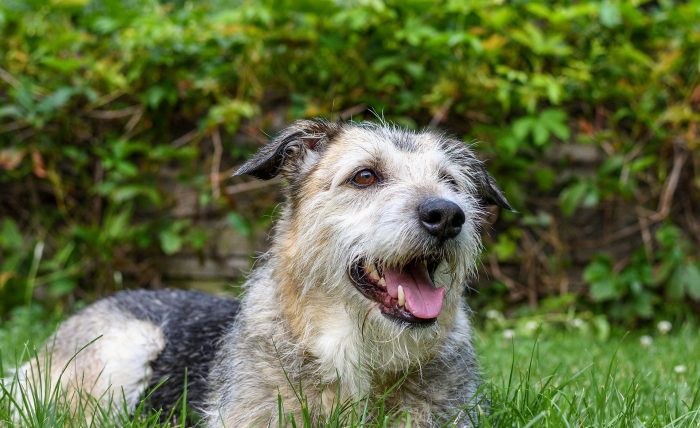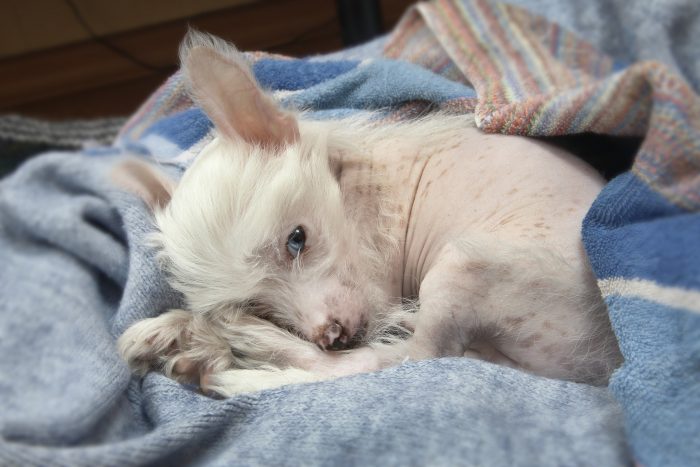Skin tumors are the most common tumors found in dogs. Sadly, their fur isn’t the armor we all thought it to be. But luckily, if caught early, the disease can often be treated successfully. While there are several different forms of skin cancer in dogs, mast cell tumors are one of the most common.
What are Mast Cell Tumors?
Canine mast cell tumors (MCTs) are the most common skin tumors on dogs. Roughly one third of all tumors in dogs are skin tumors, and up to 20 percent of those are mast cell tumors.
Mast cell tumors are cancerous proliferations of mast cells. Mast cells reside mainly in the skin, but are also plentiful in other parts of the body, such as the intestines and lungs. These cells fight against parasitic infection, help repair tissue, form new blood vessels, and are also connected to allergic reactions. Mast cell tumors invade and impair these functions and affect heart rate, blood pressure and more.
Although mostly found in the skin, MCTs can and will spread throughout the body, commonly appearing in the spleen, liver, and bone marrow. The danger from MCTs comes not from the tumors themselves, but the secondary damage caused by the release of chemicals that they produce.
Mast cell tumors are sometimes referred to as “the great imposters,” because there is no way to definitively identify them without a biopsy and pathology report. Although they are most frequently found on the trunks and limbs of dogs, MCTs can vary widely in their size, shape, appearance, texture, and location. Not only are they difficult to recognize, but it is also nearly impossible to predict their course. They can also range in their threat level from completely benign nodules to aggressively malignant.
Since MCTs are so common in canines, it’s important for any dog owner to have a basic understanding of what they are and the threat level they pose to your canine.
Diagnosis of Mast Cell Tumors in Dogs
The most common way that MCT tumors are detected is using a fine needle aspirate and cytology. Fine needle aspiration involves inserting a fine needle into the tumor to remove a few of the cells in the tumor. From there the cells are sent to cytology to be inspected for a diagnosis.
What do the Grades and Stages of MCTs mean?
Canine mast cell tumors can be relatively harmless, or in more advanced cases, pose a serious threat to the well-being of your dog. To help set a treatment plan, they are measured on a scale of grades and stages.
The “grade” refers to how likely the MCT is to be malignant. The higher the grade, the more serious the tumor, with grade I being the lowest and grade III being the highest.
- Grade I: Occur in the skin and are considered benign. Although they may be large and difficult to remove, they tend to not spread to other areas of the body. Most MCTs are Grade I.
- Grade II: Extend below the skin into the subcutaneous tissues. Their cells show some characteristics of malignancy and their response to treatment can be unpredictable.
- Grade III: Invade areas deep below the skin, are very aggressive, and require more involved treatment.
The “stage” measures how much a tumor has spread in the dog’s body. After surgery, staging is measured based on how many tumors were present, how they affected the underlying lymph nodes, and if all of the tumor was removed.
- Stage 0: One tumor in the skin incompletely removed, with no lymph node involvement.
- Stage I: One tumor in the skin, with no lymph node involvement.
- Stage II: One tumor in the skin with lymph node involvement
- Stage III: Multiple large, deep skin tumors, with or without lymph node involvement
- Stage IV: One or more tumors with metastasis in the skin with lymph node involvement. This stage is further divided into those that have no other signs (substage a) and those that have some other clinical symptoms (substage b).
What Causes Mast Cell Tumors in Dogs?
Unfortunately, no one knows for sure what causes mast cell tumors in dogs. But ongoing studies are looking into a few potential causes.
Cancer-causing or not, the sun can certainly harm your dog. Dog noses and, in some breeds, ears, are exposed to the sun’s harmful rays. Also, since they breathe through their mouths, their oral cavity is exposed as well. So don’t think of their fur as armor!
Speaking of which, take your dog’s coat into consideration as well. Dogs with light-colored or thin coats are more susceptible to sun damage, and some studies suggest that MCT development may be associated with golden or red coats. There may also be environmental factors, pre-existing illnesses, and other contributors.
What is known, however, is that there seems to be a genetic component, since some breeds seem to be more susceptible to MCTs than others. These include Boxers, Bulldogs, Pugs, Boston Terriers, Beagles, Bullmastiffs, Bull Terriers, Dachshunds, English Setters, Fox Terriers, Golden Retrievers, Labrador Retrievers, Schnauzers, American Staffordshire Terriers, and Weimaraners. Of these, Boxers are at the highest risk, yet mast cell tumors are often not as aggressive in this breed.
As with any cancer, older dogs are most likely to develop MCTs, with the average age being eight to nine.
What are the signs and symptoms of MCTs?
Mast cell cancer is most commonly found in tumor form. Mast cell tumors may appear alone or in groups and can be found almost anywhere on a dog’s body. They can be on the surface of the skin or under the skin (subcutaneous). You won’t know an MCT tumor by look or feel, but there are common signs to look for.
At least half of skin tumors on dogs are found in or under the skin on the trunk of a dog’s body. The vast majority of the rest are found on their legs, especially the hind limbs. They are rarely found on the head and neck, and even less commonly found in tissues other than the skin, although it does happen.
One characteristic MCTs do seem to have is a tendency to change in size, due to a process called degranulation. Mast cells contain granules that release various potentially harmful substances into the bloodstream when tumors become agitated, resulting in the waning of these granules, and thus a temporary decrease in the overall size of the tumor. The tumor can get larger or smaller even on a daily basis. A recent rapid growth after months of inactivity is also common. High-grade skin and subcutaneous tumors may have a sudden onset of redness and fluid build-up.
Owners can also check for Darier’s sign. This occurs when you stroke at the skin of the tumor and it changes its characteristics. It may swell, become itchy or red, or even break out in hives. This is because the mast cells, hyperactive due to the cancer, will compress.
Symptoms can vary widely depending on the location of the tumor and how far it has developed and/or spread. If the tumor is cancerous, symptoms may include:
- loss of appetite
- vomiting or bloody vomit
- diarrhea
- abdominal pain
- dark or black feces
- itchiness
- lethargy
- anorexia
- irregular heart rhythm and blood pressure
- coughing
- labored breathing
- various bleeding disorders
- delayed wound healing
- Widespread mast cell cancer can cause enlarged organs, particularly the liver and/or spleen.
Mast cell tumors are unlikely to be painful to your dog unless they are very swollen and invasive or ulcerated. Higher-grade tumors are more likely to be ulcerated and cause your dog discomfort.
What are the treatment options?
There are several ways to treat MCTs, depending on the severity of the cancer. The most common options available are surgery and radiation.
Surgical Removal and Radiation Therapy
Most often, surgery is used to remove MCTs. This will usually cure Grade I and II tumors. Since it is difficult to tell where a dog tumor begins and ends, a large area of “healthy” tissue around the tumor is also removed to take away any hidden cancerous cells. If this “wide” excision isn’t feasible, radiation may be done before surgery to shrink the tumor.
After surgery, the tumor is submitted to a lab for biopsy to generate a pathology report. The report checks to see if the margins of the surgical removal show signs of cancerous cells. If the margins are clean, no further action is needed, but if they are dirty, further surgery or local radiation may be necessary to attempt to remove or kill off any remaining cancerous cells. Regardless, most tumors that are not completely excised do not return.
Radiation therapy is highly effective in controlling mast cell cancer, but is controversial due to its cost and procedural strain on the animal. Dogs treated with radiation for MCTs may have three to five sessions per week for three to five weeks and must be anesthetized for each treatment. This can cost several thousand dollars, may require travel and/or boarding during the treatment period, and may have short or long-term side effects an owner might not want to subject their dog to.
Chemotherapy and Medications
When the cancer has spread to multiple areas, a combination of drugs is commonly used along with surgery and radiation. These drugs include vinblastine, lomustine, and a corticosteroid, such as prednisolone.
For this treatment, 2 mg/m2 of vinblastine is given intravenously weekly for four weeks, followed by four additional treatments given every two weeks. A gradual degrading dose of prednisone is given at the same time. Initially, 2 mg/kg is given orally for one week, then 1 mg/kg given orally every day for two weeks, followed by 1 mg/kg given orally every other day. The Prednisone is stopped once the vinblastine treatment is over.
It is important to note that chemotherapy and medications may come with side effects, including nausea, vomiting, dehydration, and reduced appetite.
Supportive Care
Sadly, sometimes the cancer has spread too far and all an owner can do is provide support to help control the symptoms. There are food options and supplements available for dogs as well as many techniques to help make their lives more comfortable. When it gets to this point, monitor your dog to see when their quality of life has deteriorated.
Other forms of Skin Cancer in Dogs
There are two other common forms of skin cancer in dogs.
Malignant Melanoma
Same as with people, malignant melanoma in dogs affects pigmented cells known as melanocytes. Most malignant melanomas occur on the mouth or mucous membranes, although about 10 percent are found on parts of the body covered with hair. This cancer tends to grow extremely fast and is likely to spread to other organs, including the lungs and liver.
Squamous Cell Carcinoma
Squamous cell carcinoma is a cancer that originates in the outer layer of a dog’s skin. Cutaneous squamous cell carcinomas are typically fast growing tumors that get bigger with time and resist healing. As carcinomas are malignant and particularly invasive, it is essential to have this form of skin cancer diagnosed and treated without delay.
Squamous cell carcinoma is often caused by exposure to the sun. Studies also show a possible connection between the papilloma virus and the development of squamous cell tumors in certain dogs.
What is the prognosis if my dog has MCT?
The prognosis for a dog with a Mast Cell Tumor depends on the grade and stage of the tumor. The lower the grade, the better prognosis. This goes the same for the stage of the cancer: Dogs with Stage I tumors have the best prognosis, compared to those staged higher.
A secondary consideration is the location of the tumor. Those dogs with tumors on their limbs appear to have the best prognosis. Others with tumors in the nail bed, genital areas, muzzle, and mouth have a poorer outlook. Dogs with MCTs in their internal organs, such as the spleen or bone marrow, have the least favorable prognosis.
How do I know if my dog has an MCT?
Dog skin cancer can become fatal if it goes untreated. The best thing to do is to check your dog for lumps, especially as he ages. If you find anything, it’s best not to ignore it and think of it as a natural effect of aging. To be safe, have your veterinarian check on any suspicious growth you find on your furry pal.
Does your dog suffer from canine cancer? Shop Canna-Pet products for dogs today!
Sources:
- “Mast Cell Tumor (Mastocytoma) in Dogs.” PetMD, Accessed 16 Dec. 2016. www.petmd.com/dog/conditions/cancer/c_dg_mast_cell_tumor.
- Rest, Joan. “Mast Cell Tumors in Dogs.” VCA Hospitals, Accessed 16 Dec. 2016. www.vcahospitals.com/know-your-pet/mast-cell-tumors-in-dogs.
- “Canine Mast Cell Tumors.” VetMed, Washington State University, Accessed 16 Dec. 2016. www.vth.vetmed.wsu.edu/specialties/oncology/information-for-owners/mast-cell-cancer.
- MacPete, Ruth. “Mast Cell Tumors in Dogs.” Pet Health Network, Accessed 16 Dec. 2016. www.pethealthnetwork.com/dog-health/dog-diseases-conditions-a-z/mast-cell-tumors-dogs.
- “Mast Cell Tumor: A Common Form of Cancer in Dogs and Cats.” Healthy Pets, Accessed 16 Dec. 2016. www.healthypets.mercola.com/sites/healthypets/archive/2012/03/05/common-cancer-for-pet-dogs-and-cats-mast-cell-tumors.aspx.
- “Mast Cell Tumors in Dogs.” PennVet Ryan Hospital, Accessed 23 Apr. 2019. https://www.vet.upenn.edu/docs/default-source/ryan/oncology-handouts/final-canine-mct.pdf?sfvrsn=4









